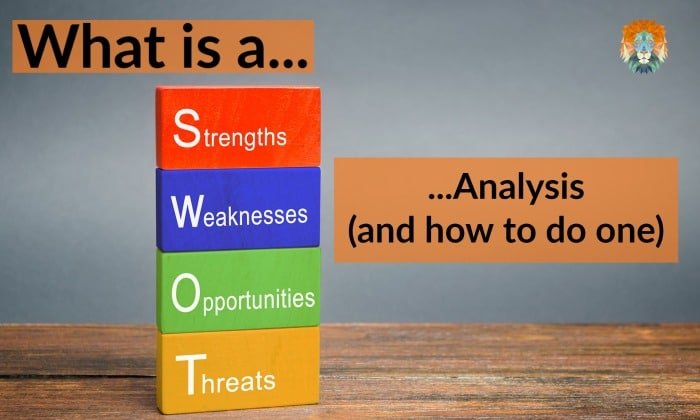Sorry, this blog isn’t anything to do with military tactics!
In the world of marketing, a SWOT analysis is one of the most common and powerful marketing tools a business can have – but it’s also one of the more unknown. It’s a way to evaluate your company, a project you’re working on or the performance of a strategy by taking a good, hard look at them in detail. Using SWOT, you can gain valuable insights into your business and the market, so you can create a strategic plan to help you meet your goals, faster. But what is a SWOT analysis, and how do you do one?
What is a SWOT Analysis?
SWOT. Strengths, Weaknesses, Opportunities, Threats.
A SWOT analysis is a business tool designed to help you develop your business and marketing strategy. Whether you’re a budding start-up or an established business, a SWOT analysis can help you make decisions about your business, discover your weaknesses, and ensure you capitalise on new opportunities as soon as possible. It also allows you to group these things into sections, so you can clearly see where you are strong, and what you need to do to improve.
When you’re first starting up your business, it’s recommended you do a SWOT analysis to get a clear view of the market and help you find your niche. But established businesses can benefit from doing them as well. They give you the chance to assess your performance, identify new chances for improvement, and tools to create a solid strategy for prioritising the work you need to do to really grow your business. That’s because doing a SWOT analysis forces you to really look at your business in a critical way. That being said, there are 2 different approaches to using SWOT analysis, which is to do one on yourself or to do one on your competitors.
SWOT for Competitors
The best way to work out how to be successful in any industry is to look at someone who already is, and work out what they’re doing right. That means spending some time finding out all about your competition and doing some analysis. Look at their website and the services or products they’re offering. Find out where they’re advertising, what their USP is, and all the different ways they market their business. Look up how much money they’re making, and how much their business has grown or shrunk in the last few years. Stalk them on social media, watch out for their ads in magazines, and generally make it your business to know what they’re doing and how they’re doing it.
As you’re gathering information, you can use that information to fill in the 4 parts of your SWOT analysis. So for each section, ask yourself:
- Strengths – What are the strong points of their business and their brand?
- Weaknesses – What are their weaknesses? What are they doing that you don’t like?
- Opportunities – What are they missing? What things could you do that they aren’t?
- Threats – What are the threats to their business model? How could you avoid them?
Some of the information you will be able to gain pretty easily – for example, you can get cold hard facts about how much money a competitor is making (or at least reporting) using Companies House. But others will be more subjective – like what the strong points and weaknesses of their brand are. Try to be as impartial and critical as possible, and you will see some really interesting differences and maybe even get some new ideas in the process.
SWOT on Yourself
Ultimately most businesses will want to turn their weaknesses into strengths, capitalise on their opportunities and reduce threats to their business. But in order to do that you need to know what those weaknesses, opportunities and threats are – which is why a SWOT analysis can be a really useful internal tool as well.
When you’re doing a SWOT analysis on your own business, there are a few things to tweak. Mainly that:
- A Strength is a positive internal factor.
- A Weakness is a negative internal factor.
- An Opportunity is a positive external factor.
- A Threat is a negative external factor.
So essentially, when doing a SWOT analysis on your own business, you should try to tackle it in two parts. The first is opening up your business and taking a long, critical look inside about your strengths and weaknesses. What are you really amazing at, and where do you maybe fall behind the curve? This gives you a baseline idea of what you can highlight in your marketing, and what you can work on to improve behind the scenes. For example, you might be a cosmetics company with an amazing quality product and great branding, but your website isn’t geared for e-commerce and your ordering isn’t integrated. So your strength would be the quality of your product, and your weakness would be your ordering system. Be as realistic as possible about the strengths and weaknesses of your business – otherwise, the exercise is a waste of time.
The second is looking externally, at the market and at your competitors for opportunities and threats. Look at what gaps there are in the market and what customers are asking for from their brands. For example, the beauty industry is crying out for better representation and inclusivity among cosmetic products and skincare right now. So if you own a beauty brand, what could you do to better cater to a more diverse range of skin tones and needs? How could you reframe your marketing to be more inclusive? In this phase, you also need to look at threats to your business model. For example, product-based businesses need to be preparing for the Plastic Packaging Tax, which could affect your profit margins.
At Lion Spirit Media, we believe that a SWOT analysis isn’t just helpful – it’s vital if you want to conquer the market and make your voice heard. With a good SWOT analysis, you can build a strong foundation for a marketing plan that will reach the right people, at the right time, and make sure your roar is the loudest in the jungle. If you’re not sure where to start with SWOT analysis, or how to use it in your marketing, we would love to help. Just get in touch to book your free, no-obligation consultation.





0 Comments